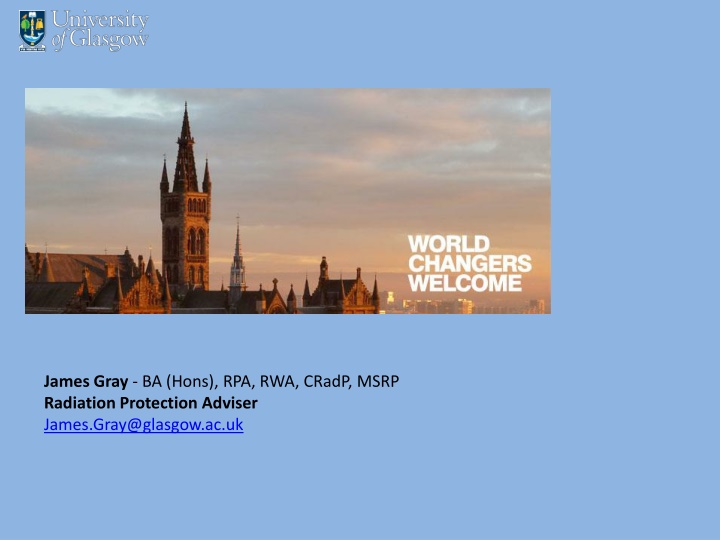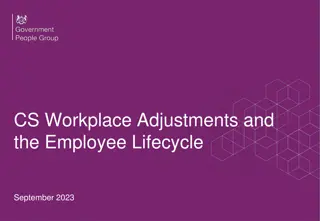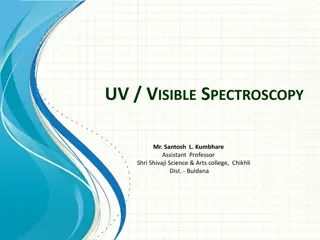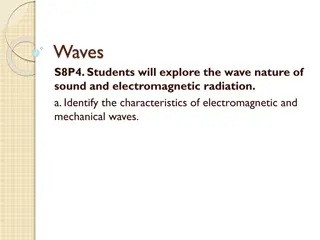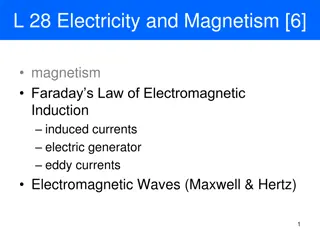Managing Electromagnetic Fields in the Workplace: Regulations and Guidelines
James Gray, an experienced Radiation Protection Adviser, provides insights on the Control of Electromagnetic Fields at Work Regulations. The content covers definitions, health effects, direct and indirect effects, and necessary actions to ensure workplace safety regarding EMFs exposure.
Download Presentation

Please find below an Image/Link to download the presentation.
The content on the website is provided AS IS for your information and personal use only. It may not be sold, licensed, or shared on other websites without obtaining consent from the author.If you encounter any issues during the download, it is possible that the publisher has removed the file from their server.
You are allowed to download the files provided on this website for personal or commercial use, subject to the condition that they are used lawfully. All files are the property of their respective owners.
The content on the website is provided AS IS for your information and personal use only. It may not be sold, licensed, or shared on other websites without obtaining consent from the author.
E N D
Presentation Transcript
James Gray - BA (Hons), RPA, RWA, CRadP, MSRP Radiation Protection Adviser James.Gray@glasgow.ac.uk
S T A T U T O R Y I N S T R U M E N T S HEALTH AND SAFETY 2016 No. 588 The Control of Electromagnetic Fields at Work Regulations 2016 (CEMFAW)
Guidance Non-binding guide to good practice for implementing Directive 2013/35/EU Electromagnetic Fields Vols 1&2 http://ec.europa.eu/social/publications A guide to the Control of Electromagnetic Fields at Work Regulations 2016 HSE http://www.hse.gov.uk/pubns/books/hsg281.htm Guide for SMEs
Definition EMFs are static electric, static magnetic and time-varying electric, magnetic and electromagnetic (radio wave) fields with frequencies up to 300 GHz.
Health Effects Two Categories of health effect 1. Thermal Effects a body absorbs the radiation leading to localised tissue heating 2. Non-thermal Effects more subtle effects
Direct Effects Indirect Effects Interference with active or passive medical devices Projectile risks from ferromagnetic objects Electric shocks or burns from a conductive object in an EM field Ignition of electrical detonators / fires / explosions
What you need to do assess the levels of EMFs to which your employees may be exposed ensure that exposure is below a set of ELVs, Exposure limit values when appropriate, devise and implement an action plan to ensure compliance with the exposure limits when appropriate, assess the risks of employees exposure and eliminate or minimise those risks. You must make sure you take employees at particular risk, such as expectant mothers and workers with active or passive implanted or body-worn medical devices, into account. provide information and training on the particular risks (if any) posed to employees by EMFs in the workplace and details of any action you are taking to remove or control them. This information should also be made available to their safety representatives, as appropriate take action if employees are exposed to EMFs in excess of the ELVs provide health surveillance or medical examination, as appropriate.
Action Levels and Exposure Limit Values ELVs are the legal limitations on the exposure of employees to EMFs and primarily relate to the levels of exposure to EMFs within the body. ALs have been produced relating to quantities which can be measured more easily.
In Practice Use the available guidance to check if you need to do anything e.g. table 3.2 Identify those workers at potential risk Any practice not noted in the guidance will have to be assessed If the business has more than 5 employees then a record of assessment must be kept Some practices are exempt
Employees at particular risk an employee who has declared to their employer a condition which may lead to a higher susceptibility to the potential effects of exposure to EMFs. This includes expectant mothers who have informed you of their condition and workers who have declared the use of active implanted medical devices (AIMDs), passive implanted medical devices (PIMDs) or body-worn medical devices (BWMDs) an employee who works in close proximity to electro- explosive devices, explosive materials or flammable atmospheres.
Assessment 5. (1) The employer must make a suitable and sufficient assessment of the levels of electromagnetic fields to which employees may be exposed. (2) Where regulation 4(1) applies (a) the assessment must demonstrate whether that regulation is complied with, if necessary through the use of calculations and measurements; and (b) the employer may, in accordance with the Schedule(c), assess exposure against the ALs in order to determine that specific ELVs are not exceeded. (3) The assessment may take into account (a) emission information and other safety related data provided by the manufacturer or distributor of equipment; (b) industry standards and guidelines; (c) guidance produced by the European Commission; and (d) guidance produced by the Executive. (4) The employer must review the assessment when (a) there is reason to suspect it is no longer valid; or (b) there has been a significant change in the matters to which it relates, and make such changes to it as are necessary to ensure it remains suitable and sufficient.
Assessment Action Level (AL) level at which a formal assessment is required Exposure Limit Value (ELV) legal exposure limits for employees Measurement is a last resort Information from Manufacturer Calculations
Summary Most employers won t need to do anything Workers at particular risk AL s and ELV s Guidance EU & HSE James.gray@glasgow.ac.uk
